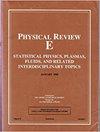斑马的条纹是如何形成的?依赖曲率的扩散使图灵图案在三维表面上定向
IF 2.4
3区 物理与天体物理
Q1 Mathematics
引用次数: 0
摘要
许多动物的皮毛、羽毛或鳞片上都有图案,如斑马的条纹。图灵模型或反应-扩散系统是一类相互作用物种的数学模型,已被成功用于为许多物种生成类似动物的图案。当抑制剂相对于激活剂的扩散量足够大时,扩散驱动的不稳定性就会自发形成图案。然而,重要的不仅是图案的类型,还有图案的方向,而图案在实践中是如何定向的仍不清楚。在这里,我们提出了一种表面曲率影响扩散速度的机制,并能在数值模拟中重现斑马和猫模型上条纹的正确方向。以前的研究表明,各向异性的扩散如何使条纹形成的反应-扩散系统在方向上产生偏差。根据观察到的斑马条纹围绕曲率最大的方向(即围绕躯干和腿部)运行,我们根据局部曲率修改了各向异性扩散率,从而应用了这一结果。这些结果表明了局部几何如何影响反应动力学,从而产生稳健的全局模式。总之,该模型提出了系统几何与反应-扩散动力学之间的耦合,只需利用局部曲率信息就能对图案进行全局控制。这种模型可以在动物发育过程中提供形状和定位信息,而无需依赖空间形态发生梯度。本文章由计算机程序翻译,如有差异,请以英文原文为准。

How the zebra got its stripes: Curvature-dependent diffusion orients Turing patterns on three-dimensional surfaces
Many animals have patterned fur, feathers, or scales, such as the stripes of a zebra. Turing models, or reaction-diffusion systems, are a class of mathematical models of interacting species that have been successfully used to generate animal-like patterns for many species. When diffusion of the inhibitor is high enough relative to the activator, a diffusion-driven instability can spontaneously form patterns. However, it is not just the type of pattern but also the orientation that matters, and it remains unclear how patterns are oriented in practice. Here, we propose a mechanism by which the curvature of the surface influences the rate of diffusion, and can recapture the correct orientation of stripes on models of a zebra and of a cat in numerical simulations. Previous work has shown how anisotropic diffusion can give stripe forming reaction-diffusion systems a bias in orientation. From the observation that zebra stripes run around the direction of highest curvature, that is around the torso and legs, we apply this result by modifying the anisotropic diffusion rates based on the local curvature. These results show how local geometry can influence the reaction dynamics to give robust, global-scale patterns. Overall, this model proposes a coupling between the system geometry and reaction-diffusion dynamics that can give global control over the patterning by using only local curvature information. Such a model can give shape and positioning information in animal development without the need for spatially dependent morphogen gradients.
求助全文
通过发布文献求助,成功后即可免费获取论文全文。
去求助
来源期刊

Physical review. E
物理-物理:流体与等离子体
CiteScore
4.60
自引率
16.70%
发文量
0
审稿时长
3.3 months
期刊介绍:
Physical Review E (PRE), broad and interdisciplinary in scope, focuses on collective phenomena of many-body systems, with statistical physics and nonlinear dynamics as the central themes of the journal. Physical Review E publishes recent developments in biological and soft matter physics including granular materials, colloids, complex fluids, liquid crystals, and polymers. The journal covers fluid dynamics and plasma physics and includes sections on computational and interdisciplinary physics, for example, complex networks.
 求助内容:
求助内容: 应助结果提醒方式:
应助结果提醒方式:


